|
|
|

Topics in this section: work and trade | leisure activities | hunting and fishing | food and drink | health and wellbeing | dress
In this section on "work and trade" we follow four different trades:
Peasant farmers: cultivating the land ...
 |
 |
Life in ancient Egypt focused largely on agriculture. A majority of the population were involved in farming, and the growing season lasted around eight to nine months. Wheat, fruits and vegetables were the principal crops, although there was some pastoral farming of cattle, sheep, or goats.
|
| The Egyptians cultivated three kinds of wheat, several types of barley and flax, their main source of textile fibre. For a second crop, or in garden plots, a wide variety of vegetables were grown including onions, garlic, leek, Egyptian lettuce, radishes, cabbage, asparagus, cucumbers, lentils, peas, beans and many spices. |
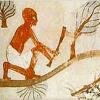 |
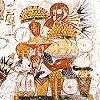 |
 |
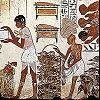 |
Valuable vegetable oils were extracted from sesame, flax and castor oil seeds. The floods meant a period of respite for the farmer, unless he was called up into army service or public works. At the height of the floods, usually around mid August, each farmer would row around his land closing the vents in the surrounding dykes.
|
When the Nile subsided, the water would slowly run off, leaving behind all the fertile mud and silt which would then soak down deep into the soil. About a month and a half afterwards, the farmer would return to release the remaining water, now turned brackish through evaporation.
| Once the water had completely drained away and the ground was firm enough to walk over, the fields were ploughed once or twice with oxen pulling the ploughs. Using hoes, the remaining clumps of soil were broken up. When the seed was thrown over the field, animals were again used to tramp the seeds into the soil. |
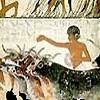 |
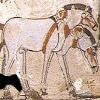 |
Irrigation ...
Irrigation was essential to a good harvest. Farmers used two main methods of artificial irrigation:
|
Catch basins: Small canals feeding from the Nile and would connect into small dykes. The canals channelled the flood waters from the Nile into the dykes, and the farmer could then open the dykes and water the fields.
|
|
Shaduf: Introduced during the New Kingdom period, the shaduf was ideal for irrigating any higher lying land. A large pole balanced on a crossbeam with a rope and bucket on one end and a heavy counter weight at the other. By pulling the rope it lowered the bucket into the Nile and the counterweight would raise the bucket to a level where it could be emptied into a channel or gully or cistern at the edge of the field.
The shaduf increased the quantity of the grain harvest and the area of land available for crop growing. You can still see the shaduf in use today along the banks of the Nile in Upper Egypt.
|
The provisioning of water for the fields and the maintenance of the irrigation works were communal responsibilities, but local landowners, particularly the provincial nobles, were much more involved than the central government.
Landowners ...
 Farming and agriculture were central to the Ancient Egyptian society, and as such, most of the population were directly involved with farming, with the exception of royalty, nobility and the scribes. Members of the nobility were still involved in the economic side of agriculture as they often owned the farmland and would supervise the farming process. Farming and agriculture were central to the Ancient Egyptian society, and as such, most of the population were directly involved with farming, with the exception of royalty, nobility and the scribes. Members of the nobility were still involved in the economic side of agriculture as they often owned the farmland and would supervise the farming process.
Full time farmers would generally work the land of wealthy landowners, and would be paid in food, clothes and shelter. Families would sometimes rent land from the landowners, and would be obliged to give the landowner a percentage of their crop yield as payment.
Others, perhaps less fortunate, would dredge canals, survey land and prepare the ground as a form of taxation to the central government. This was known as being drafted through corvee. If you tried to avoid your corvee, you and your family could risk punishment.
| The peasant farmers were usually tied to the land that they worked. This land could be administered by the state, belong to a temple complex, or even form part of a tomb endowment. Even if the land was sold on or changed hands, the farmers were still obliged to work that land. |
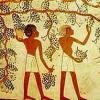 |
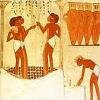 |
Land tenure would occasionally change hands following political currents, but it is unlikely that these changes would have altered the nature or manner of the farmer's work to any great extent.
Discover life as a craftsman in Ancient Egypt >>
|
|
|






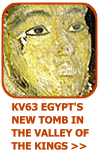










 Farming and agriculture were central to the Ancient Egyptian society, and as such, most of the population were directly involved with farming, with the exception of royalty, nobility and the scribes. Members of the nobility were still involved in the economic side of agriculture as they often owned the farmland and would supervise the farming process.
Farming and agriculture were central to the Ancient Egyptian society, and as such, most of the population were directly involved with farming, with the exception of royalty, nobility and the scribes. Members of the nobility were still involved in the economic side of agriculture as they often owned the farmland and would supervise the farming process.
